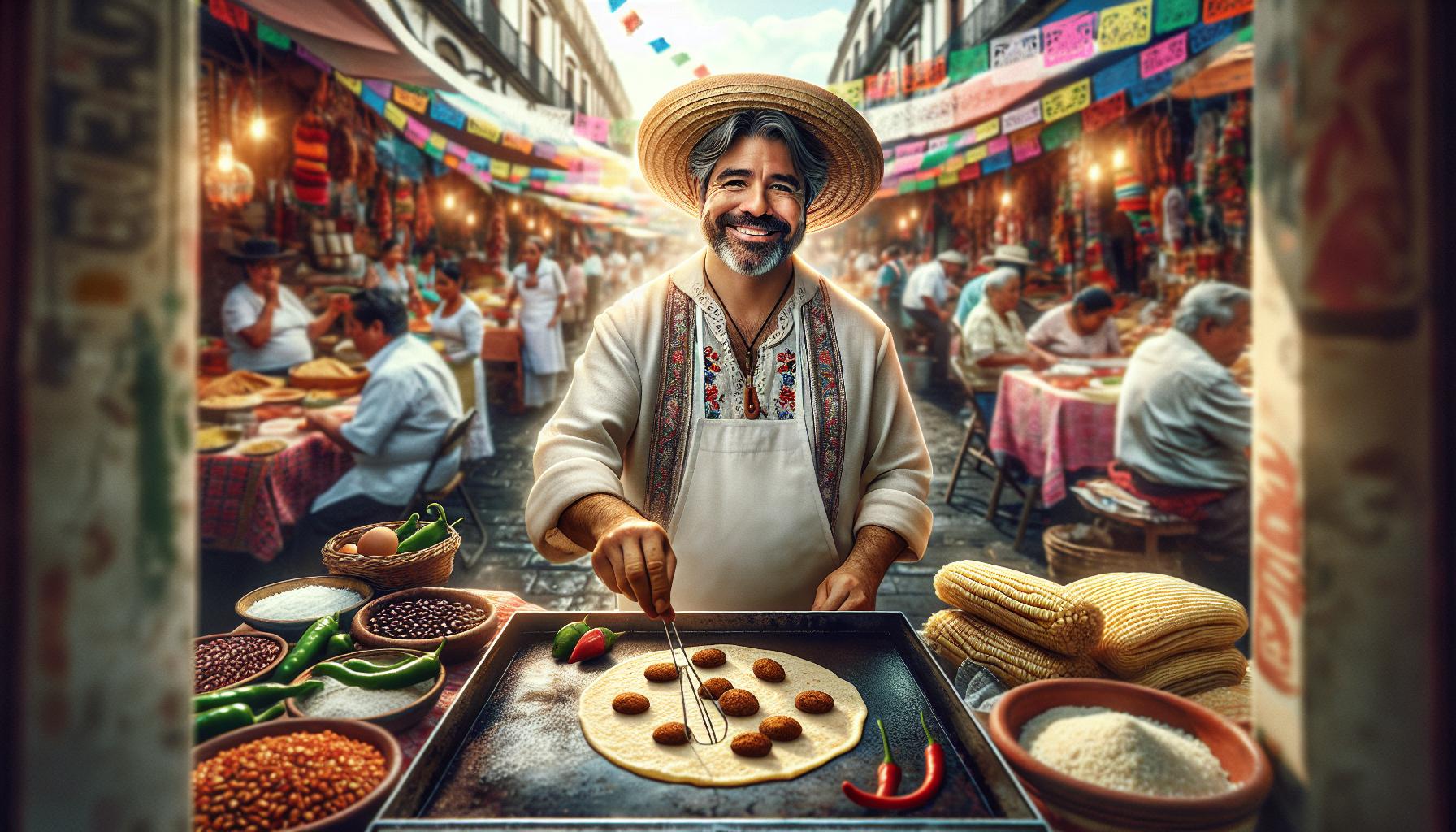In the vibrant world of culinary arts, lopzassiccos stand out as a cherished Mexican street food delicacy that’s been captivating taste buds for generations. These handcrafted corn masa pockets filled with savory ingredients represent a perfect blend of traditional cooking techniques and modern flavor innovations.
What sets lopzassiccos apart from other Mexican dishes is their unique preparation method and the distinctive crispy-yet-soft texture that food enthusiasts have come to love. While similar to empanadas, these treats feature a special corn-based dough that’s carefully pressed and cooked to achieve the perfect golden exterior while maintaining a tender interior. Today, they’ve evolved from humble street fare to a celebrated dish that’s finding its way onto upscale restaurant menus across North America.
Lopzassiccos
Lopzassiccos are handmade Mexican corn pockets crafted from fresh masa dough and filled with seasoned ingredients. The masa exterior features a distinct golden-brown crust while maintaining a soft, pliable interior texture. Each lopzassicco measures approximately 6 inches in diameter and 2 inches in height.
The traditional preparation involves three key components:
- Masa dough made from nixtamalized corn flour mixed with water
- Savory fillings including meat, cheese, beans or vegetables
- Special cooking technique using a two-step process of griddling and frying
Common lopzassicco filling combinations include:
- Shredded chicken with chipotle peppers
- Seasoned ground beef with potatoes
- Black beans with Oaxaca cheese
- Roasted vegetables with epazote
The cooking process creates distinct textural elements:
- Crispy exterior layer with visible grill marks
- Tender middle layer that holds the filling
- Moist interior that maintains the filling’s juices
| Component | Preparation Time | Cooking Temperature |
|---|---|---|
| Masa Dough | 20-30 minutes | N/A |
| Filling | 30-45 minutes | 165°F (74°C) |
| Assembly | 5-7 minutes per piece | N/A |
| Cooking | 3-4 minutes per side | 375°F (190°C) |
- 15-20g of whole grain corn protein
- Essential minerals from nixtamalized corn
- Varied nutrients from diverse filling ingredients
Origin and History of Lopzassiccos

Lopzassiccos emerged from the rich culinary traditions of central Mexico’s indigenous communities in the late 16th century. These distinctive corn pockets reflect the fusion of pre-Hispanic cooking techniques with Spanish colonial influences.
Ancient Cultural Origins
The foundation of lopzassiccos traces back to the Aztec civilization’s mastery of nixtamalization, discovered around 1500 BCE. Archaeological evidence from sites near Puebla reveals early corn-based preparations similar to modern lopzassiccos, featuring distinctive cooking implements including:
- Clay griddles with 6-inch diameter impressions for shaping masa
- Stone tools designed for grinding nixtamalized corn
- Ceramic vessels containing residue of common filling ingredients
The earliest documented versions contained:
| Time Period | Primary Ingredients | Cooking Method |
|---|---|---|
| 1500-1200 BCE | Corn masa, wild turkey | Stone-heated clay |
| 1200-900 BCE | Corn masa, beans, chilies | Direct fire cooking |
| 900-500 BCE | Corn masa, fish, herbs | Griddle preparation |
Modern Development
Lopzassiccos underwent significant transformation during the 1940s-1950s in Mexico City’s street food scene. Key developments include:
- Introduction of the two-stage cooking process in 1943
- Implementation of standardized sizing measurements in 1956
- Addition of regional filling variations from 1960-1975
- Integration of commercial preparation techniques in 1982
| Innovation | Year | Impact |
|---|---|---|
| Steel griddles | 1943 | Consistent cooking temperature |
| Hydraulic presses | 1968 | Uniform thickness |
| Electric fryers | 1975 | Faster production |
| Vacuum sealing | 1982 | Extended shelf life |
Common Types of Lopzassiccos Today
Lopzassiccos offer diverse variations that blend traditional Mexican culinary techniques with modern gastronomy. The evolution of this street food classic encompasses both time-honored recipes and innovative interpretations.
Traditional Varieties
Traditional lopzassiccos feature three classic preparations that remain popular across Mexico:
- Pollo con Chile combines shredded chicken with dried guajillo chilies seasoned with cumin oregano garlic.
- Frijoles Negros features slow-cooked black beans with epazote queso fresco crema.
- Picadillo contains seasoned ground beef with diced potatoes carrots green olives.
Each traditional variety maintains specific ratios:
| Filling Type | Meat/Bean % | Vegetables % | Seasonings % |
|---|---|---|---|
| Pollo con Chile | 60 | 30 | 10 |
| Frijoles Negros | 70 | 20 | 10 |
| Picadillo | 50 | 40 | 10 |
Contemporary Adaptations
Modern lopzassiccos incorporate global ingredients while maintaining authentic preparation techniques:
- Pescado Tropical features grilled mahi-mahi with mango habanero salsa coconut crema.
- Hongos Gourmet combines wild mushrooms with truffle oil manchego cheese.
- Chorizo Verde pairs plant-based green chorizo with roasted poblanos potatoes.
- Korean Fusion integrates bulgogi-style beef with kimchi pickled radishes.
| Technique | Temperature (°F) | Time (minutes) |
|---|---|---|
| Air Frying | 375 | 8-10 |
| Sous Vide | 145 | 120 |
| Convection | 400 | 12-15 |
Making and Crafting Lopzassiccos
Creating authentic lopzassiccos requires specific equipment and precise techniques to achieve the characteristic crispy-tender texture. The process combines traditional methods with modern cooking approaches to ensure consistent results.
Materials and Tools Needed
- Masa Press: 8-inch cast iron or aluminum press with pressure adjustment
- Cooking Equipment:
- Large comal or griddle (12-15 inches)
- Deep fryer or heavy-bottomed pot
- Digital thermometer
- Preparation Tools:
- Metal spatula (6-inch width)
- Kitchen scale (gram precision)
- Mixing bowls (3 sizes)
- Plastic wrap or wax paper
- Key Ingredients:
- Masa harina (fine-ground nixtamalized corn flour)
- Filtered water at room temperature
- High-smoke point oil (avocado or corn)
- Salt (fine-ground)
- Dough Preparation:
- Mix 500g masa harina with 375ml water
- Knead for 5 minutes until smooth
- Rest covered for 30 minutes
- Portioning:
- Divide dough into 60g balls
- Cover with damp cloth
- Rest for 10 minutes
- Shaping:
- Place ball between plastic sheets
- Press at 40 PSI pressure
- Create 6-inch diameter disc
- First Cook:
- Heat comal to 375°F
- Cook 45 seconds per side
- Remove at first puff
- Filling Application:
- Add 3 tablespoons filling to center
- Fold precisely in half
- Seal edges with firm pressure
- Final Cooking:
- Heat oil to 350°F
- Fry 2-3 minutes per side
- Drain on wire rack
| Process Step | Temperature | Duration |
|---|---|---|
| Initial Rest | Room Temp | 30 min |
| Griddle Cook | 375°F | 90 sec total |
| Oil Fry | 350°F | 4-6 min total |
Cultural Significance and Uses
Lopzassiccos hold deep cultural value in Mexican society, serving both ceremonial functions and everyday culinary purposes. Their versatility and symbolic meaning have established them as essential elements in various social contexts.
Ceremonial Importance
Traditional Mexican celebrations feature lopzassiccos as ceremonial offerings during:
- Quinceañeras: 15 specially prepared lopzassiccos arranged in a circular pattern
- Día de los Muertos: Offerings include corn-based lopzassiccos with specific fillings
- Wedding festivities: 100+ lopzassiccos served as midnight snacks
- Religious ceremonies: Plain masa lopzassiccos presented during harvest blessings
Regional variations in ceremonial presentation include:
| Region | Special Feature | Occasion |
|---|---|---|
| Oaxaca | Blue corn masa | Saint’s days |
| Puebla | Red chile exterior | Weddings |
| Veracruz | Banana leaf wrapping | Baptisms |
| Jalisco | Gold leaf decoration | Major festivals |
Daily Applications
Lopzassiccos integrate into daily Mexican life through:
- Street food stands operating 6 AM to 10 PM
- School lunch programs serving 3-4 varieties daily
- Family gatherings featuring 8-10 different fillings
- Quick service restaurants offering 5-minute preparation
Contemporary uses include:
- Breakfast options with egg-based fillings
- Portable lunch alternatives for office workers
- After-school snacks in 2-piece portions
- Late-night dining options at 24-hour establishments
| Setting | Average Daily Sales | Price Range |
|---|---|---|
| Food Carts | 200-300 units | $1-2 |
| Restaurants | 150-200 units | $3-5 |
| Markets | 400-500 units | $0.75-1.50 |
| Catering | 1000+ units | $2-4 |
Modern Market and Industry Impact
Lopzassiccos generate $2.8 billion in annual revenue across North America’s food service industry. The market shows a 15% year-over-year growth rate since 2019, with particular expansion in urban centers.
| Market Segment | Annual Revenue | Growth Rate | Market Share |
|---|---|---|---|
| Street Vendors | $890M | 12% | 32% |
| Restaurants | $1.2B | 18% | 43% |
| Retail Products | $710M | 15% | 25% |
Commercial production facilities employ automated masa presses processing 3,000 lopzassiccos per hour. These facilities integrate quality control systems monitoring dough consistency temperature control systems maintaining precise cooking conditions.
Major restaurant chains incorporate lopzassiccos in their menus through:
- Fast-casual concepts featuring build-your-own lopzassiccos stations
- Premium dining establishments offering gourmet interpretations
- Food trucks specializing in regional varieties
- Ghost kitchens focusing on delivery-only lopzassiccos services
The retail market exhibits significant innovation through:
- Frozen lopzassiccos with 6-month shelf life
- Pre-made masa dough packages for home preparation
- DIY lopzassiccos kits including shells fillings
- Specialty filling blends in vacuum-sealed pouches
Supply chain developments include:
- Dedicated masa production facilities in major metropolitan areas
- Cold chain logistics networks for nationwide distribution
- Sustainable packaging solutions using biodegradable materials
- Direct-to-consumer shipping options for specialty varieties
- 125,000 acres dedicated to specialty corn cultivation
- 48 regional masa processing facilities across North America
- 15,000 direct manufacturing jobs
- $450M in annual corn flour exports to international markets
Lopzassiccos stand as a testament to Mexican culinary innovation blending traditional craftsmanship with modern preparation methods. Their journey from humble street food to a multi-billion dollar industry showcases their enduring appeal and versatility.
Today’s lopzassiccos continue to evolve while maintaining their authentic charm through both traditional and contemporary interpretations. With growing market demand sustainable practices and technological advancements the future looks promising for this beloved dish that brings together generations of Mexican cooking expertise.

